Importance of Leadership and Management Theories in Organizations
VerifiedAdded on 2023/01/12
|11
|4711
|63
AI Summary
This article discusses the importance of leadership and management theories in organizations. It explores the similarities between leadership and management, different theories of leadership, and the significance of leadership development programs. The article also highlights how leadership influences employee behavior and the benefits of effective leadership in achieving organizational goals.
Contribute Materials
Your contribution can guide someone’s learning journey. Share your
documents today.
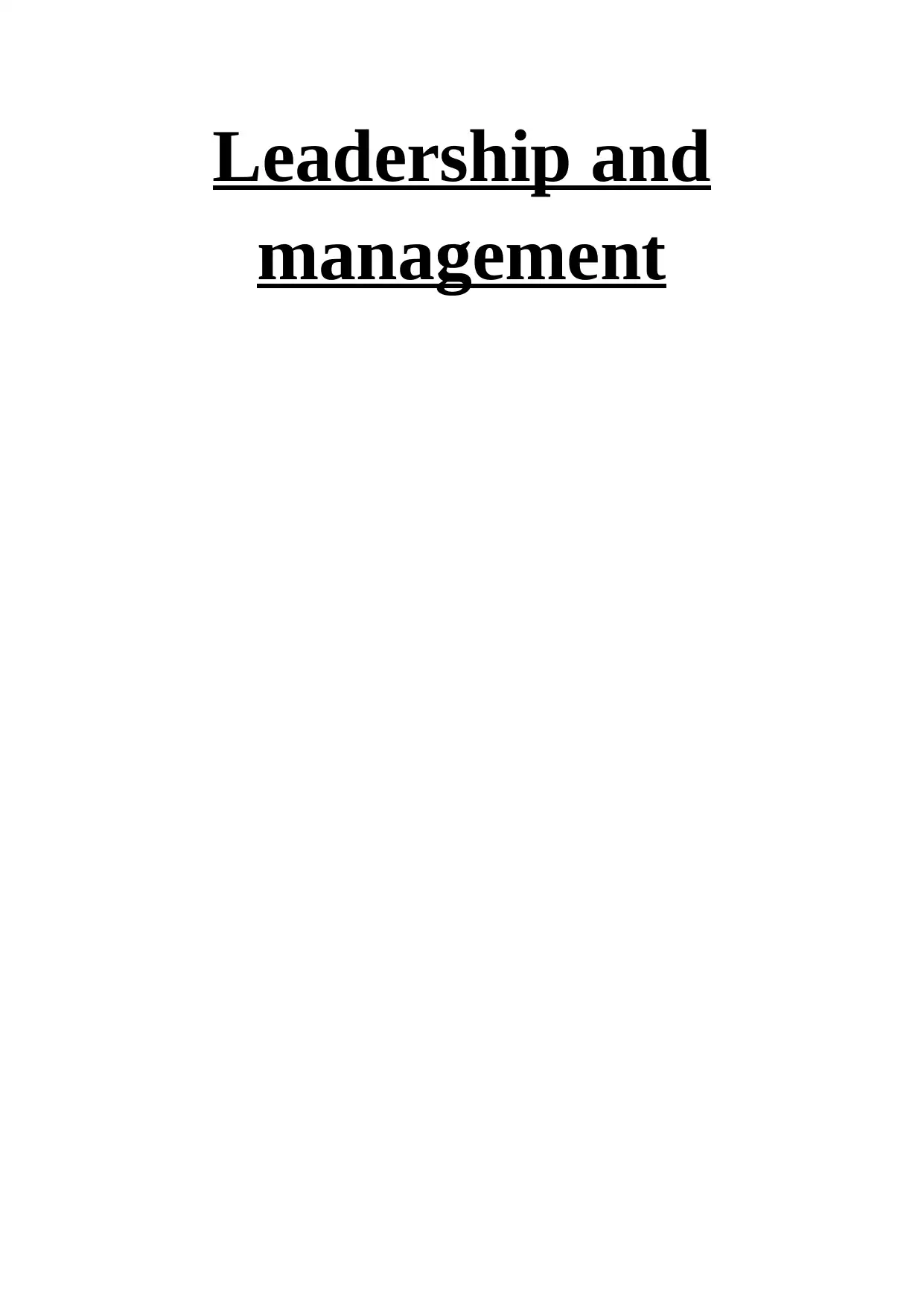
Leadership and
management
management
Secure Best Marks with AI Grader
Need help grading? Try our AI Grader for instant feedback on your assignments.
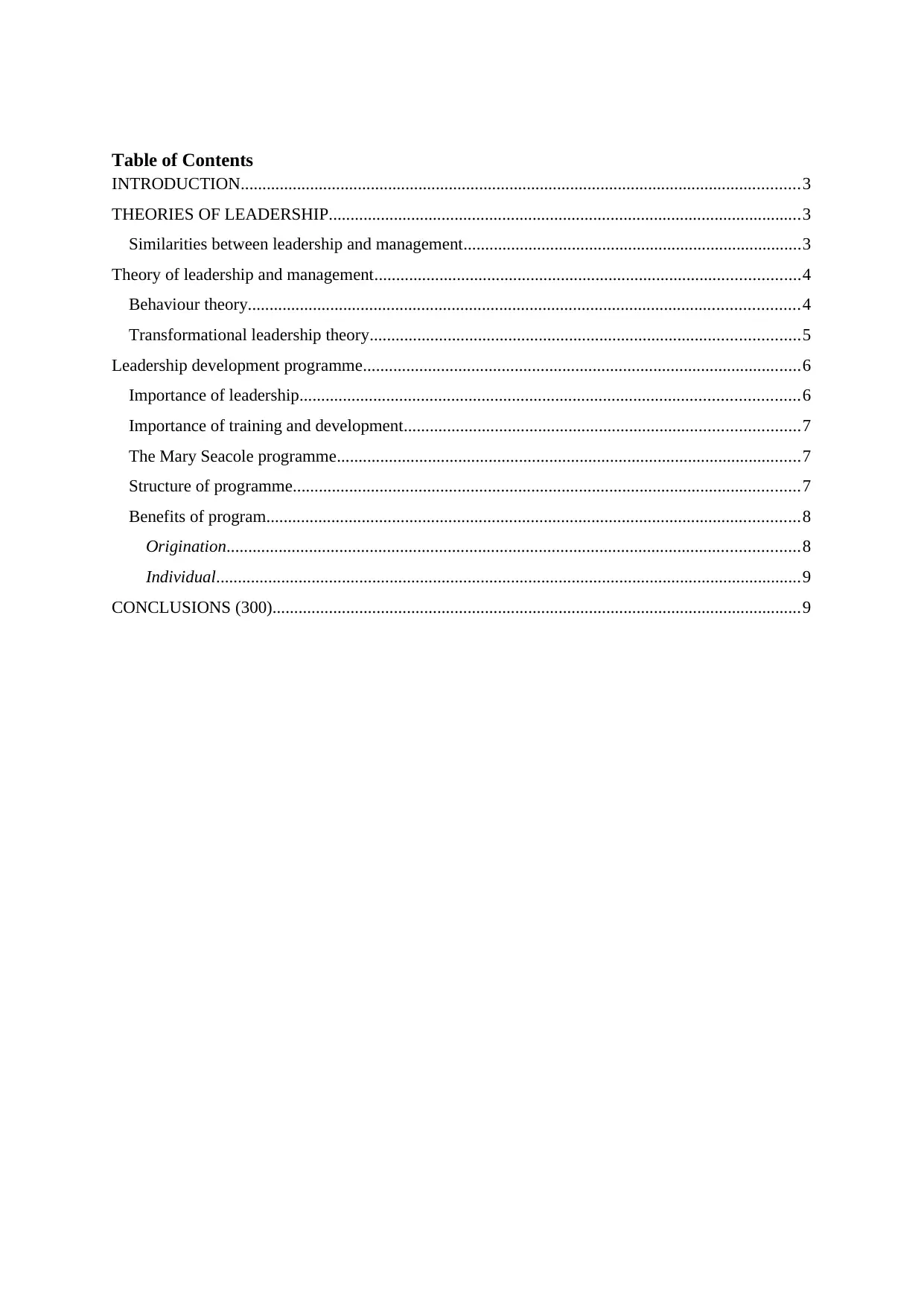
Table of Contents
INTRODUCTION.................................................................................................................................3
THEORIES OF LEADERSHIP.............................................................................................................3
Similarities between leadership and management..............................................................................3
Theory of leadership and management..................................................................................................4
Behaviour theory...............................................................................................................................4
Transformational leadership theory...................................................................................................5
Leadership development programme.....................................................................................................6
Importance of leadership...................................................................................................................6
Importance of training and development...........................................................................................7
The Mary Seacole programme...........................................................................................................7
Structure of programme.....................................................................................................................7
Benefits of program...........................................................................................................................8
Origination....................................................................................................................................8
Individual.......................................................................................................................................9
CONCLUSIONS (300)..........................................................................................................................9
INTRODUCTION.................................................................................................................................3
THEORIES OF LEADERSHIP.............................................................................................................3
Similarities between leadership and management..............................................................................3
Theory of leadership and management..................................................................................................4
Behaviour theory...............................................................................................................................4
Transformational leadership theory...................................................................................................5
Leadership development programme.....................................................................................................6
Importance of leadership...................................................................................................................6
Importance of training and development...........................................................................................7
The Mary Seacole programme...........................................................................................................7
Structure of programme.....................................................................................................................7
Benefits of program...........................................................................................................................8
Origination....................................................................................................................................8
Individual.......................................................................................................................................9
CONCLUSIONS (300)..........................................................................................................................9
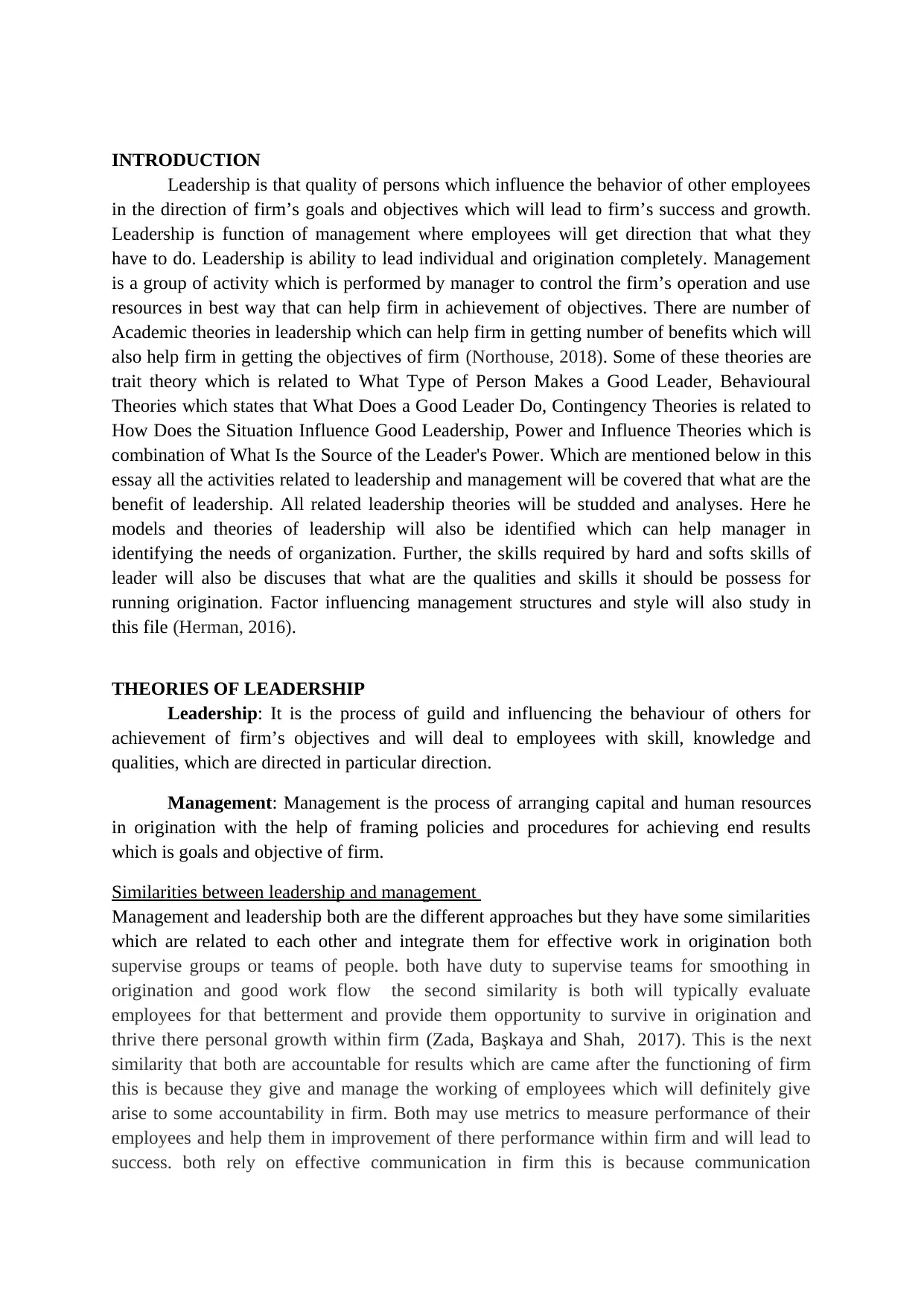
INTRODUCTION
Leadership is that quality of persons which influence the behavior of other employees
in the direction of firm’s goals and objectives which will lead to firm’s success and growth.
Leadership is function of management where employees will get direction that what they
have to do. Leadership is ability to lead individual and origination completely. Management
is a group of activity which is performed by manager to control the firm’s operation and use
resources in best way that can help firm in achievement of objectives. There are number of
Academic theories in leadership which can help firm in getting number of benefits which will
also help firm in getting the objectives of firm (Northouse, 2018). Some of these theories are
trait theory which is related to What Type of Person Makes a Good Leader, Behavioural
Theories which states that What Does a Good Leader Do, Contingency Theories is related to
How Does the Situation Influence Good Leadership, Power and Influence Theories which is
combination of What Is the Source of the Leader's Power. Which are mentioned below in this
essay all the activities related to leadership and management will be covered that what are the
benefit of leadership. All related leadership theories will be studded and analyses. Here he
models and theories of leadership will also be identified which can help manager in
identifying the needs of organization. Further, the skills required by hard and softs skills of
leader will also be discuses that what are the qualities and skills it should be possess for
running origination. Factor influencing management structures and style will also study in
this file (Herman, 2016).
THEORIES OF LEADERSHIP
Leadership: It is the process of guild and influencing the behaviour of others for
achievement of firm’s objectives and will deal to employees with skill, knowledge and
qualities, which are directed in particular direction.
Management: Management is the process of arranging capital and human resources
in origination with the help of framing policies and procedures for achieving end results
which is goals and objective of firm.
Similarities between leadership and management
Management and leadership both are the different approaches but they have some similarities
which are related to each other and integrate them for effective work in origination both
supervise groups or teams of people. both have duty to supervise teams for smoothing in
origination and good work flow the second similarity is both will typically evaluate
employees for that betterment and provide them opportunity to survive in origination and
thrive there personal growth within firm (Zada, Başkaya and Shah, 2017). This is the next
similarity that both are accountable for results which are came after the functioning of firm
this is because they give and manage the working of employees which will definitely give
arise to some accountability in firm. Both may use metrics to measure performance of their
employees and help them in improvement of there performance within firm and will lead to
success. both rely on effective communication in firm this is because communication
Leadership is that quality of persons which influence the behavior of other employees
in the direction of firm’s goals and objectives which will lead to firm’s success and growth.
Leadership is function of management where employees will get direction that what they
have to do. Leadership is ability to lead individual and origination completely. Management
is a group of activity which is performed by manager to control the firm’s operation and use
resources in best way that can help firm in achievement of objectives. There are number of
Academic theories in leadership which can help firm in getting number of benefits which will
also help firm in getting the objectives of firm (Northouse, 2018). Some of these theories are
trait theory which is related to What Type of Person Makes a Good Leader, Behavioural
Theories which states that What Does a Good Leader Do, Contingency Theories is related to
How Does the Situation Influence Good Leadership, Power and Influence Theories which is
combination of What Is the Source of the Leader's Power. Which are mentioned below in this
essay all the activities related to leadership and management will be covered that what are the
benefit of leadership. All related leadership theories will be studded and analyses. Here he
models and theories of leadership will also be identified which can help manager in
identifying the needs of organization. Further, the skills required by hard and softs skills of
leader will also be discuses that what are the qualities and skills it should be possess for
running origination. Factor influencing management structures and style will also study in
this file (Herman, 2016).
THEORIES OF LEADERSHIP
Leadership: It is the process of guild and influencing the behaviour of others for
achievement of firm’s objectives and will deal to employees with skill, knowledge and
qualities, which are directed in particular direction.
Management: Management is the process of arranging capital and human resources
in origination with the help of framing policies and procedures for achieving end results
which is goals and objective of firm.
Similarities between leadership and management
Management and leadership both are the different approaches but they have some similarities
which are related to each other and integrate them for effective work in origination both
supervise groups or teams of people. both have duty to supervise teams for smoothing in
origination and good work flow the second similarity is both will typically evaluate
employees for that betterment and provide them opportunity to survive in origination and
thrive there personal growth within firm (Zada, Başkaya and Shah, 2017). This is the next
similarity that both are accountable for results which are came after the functioning of firm
this is because they give and manage the working of employees which will definitely give
arise to some accountability in firm. Both may use metrics to measure performance of their
employees and help them in improvement of there performance within firm and will lead to
success. both rely on effective communication in firm this is because communication
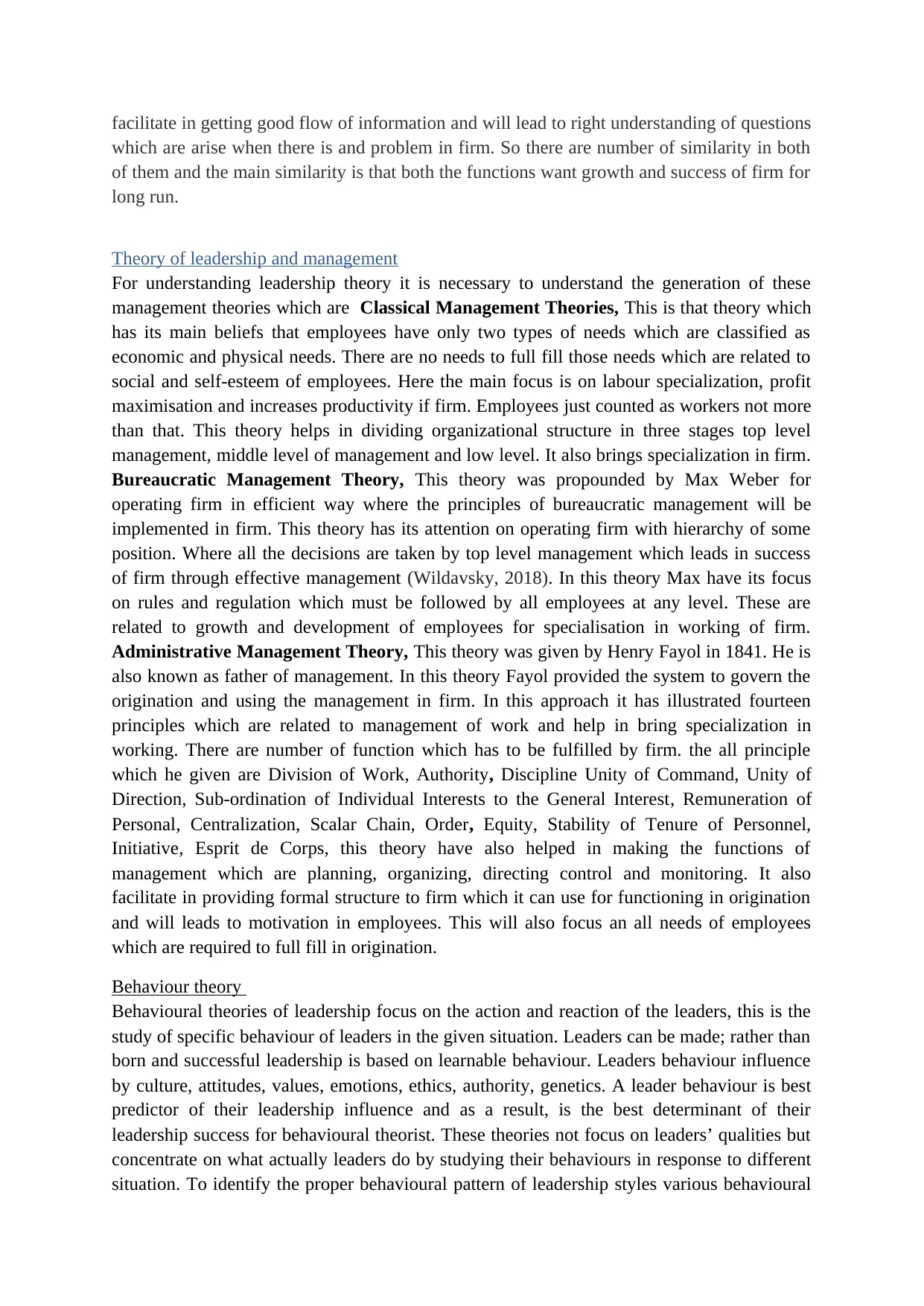
facilitate in getting good flow of information and will lead to right understanding of questions
which are arise when there is and problem in firm. So there are number of similarity in both
of them and the main similarity is that both the functions want growth and success of firm for
long run.
Theory of leadership and management
For understanding leadership theory it is necessary to understand the generation of these
management theories which are Classical Management Theories, This is that theory which
has its main beliefs that employees have only two types of needs which are classified as
economic and physical needs. There are no needs to full fill those needs which are related to
social and self-esteem of employees. Here the main focus is on labour specialization, profit
maximisation and increases productivity if firm. Employees just counted as workers not more
than that. This theory helps in dividing organizational structure in three stages top level
management, middle level of management and low level. It also brings specialization in firm.
Bureaucratic Management Theory, This theory was propounded by Max Weber for
operating firm in efficient way where the principles of bureaucratic management will be
implemented in firm. This theory has its attention on operating firm with hierarchy of some
position. Where all the decisions are taken by top level management which leads in success
of firm through effective management (Wildavsky, 2018). In this theory Max have its focus
on rules and regulation which must be followed by all employees at any level. These are
related to growth and development of employees for specialisation in working of firm.
Administrative Management Theory, This theory was given by Henry Fayol in 1841. He is
also known as father of management. In this theory Fayol provided the system to govern the
origination and using the management in firm. In this approach it has illustrated fourteen
principles which are related to management of work and help in bring specialization in
working. There are number of function which has to be fulfilled by firm. the all principle
which he given are Division of Work, Authority, Discipline Unity of Command, Unity of
Direction, Sub-ordination of Individual Interests to the General Interest, Remuneration of
Personal, Centralization, Scalar Chain, Order, Equity, Stability of Tenure of Personnel,
Initiative, Esprit de Corps, this theory have also helped in making the functions of
management which are planning, organizing, directing control and monitoring. It also
facilitate in providing formal structure to firm which it can use for functioning in origination
and will leads to motivation in employees. This will also focus an all needs of employees
which are required to full fill in origination.
Behaviour theory
Behavioural theories of leadership focus on the action and reaction of the leaders, this is the
study of specific behaviour of leaders in the given situation. Leaders can be made; rather than
born and successful leadership is based on learnable behaviour. Leaders behaviour influence
by culture, attitudes, values, emotions, ethics, authority, genetics. A leader behaviour is best
predictor of their leadership influence and as a result, is the best determinant of their
leadership success for behavioural theorist. These theories not focus on leaders’ qualities but
concentrate on what actually leaders do by studying their behaviours in response to different
situation. To identify the proper behavioural pattern of leadership styles various behavioural
which are arise when there is and problem in firm. So there are number of similarity in both
of them and the main similarity is that both the functions want growth and success of firm for
long run.
Theory of leadership and management
For understanding leadership theory it is necessary to understand the generation of these
management theories which are Classical Management Theories, This is that theory which
has its main beliefs that employees have only two types of needs which are classified as
economic and physical needs. There are no needs to full fill those needs which are related to
social and self-esteem of employees. Here the main focus is on labour specialization, profit
maximisation and increases productivity if firm. Employees just counted as workers not more
than that. This theory helps in dividing organizational structure in three stages top level
management, middle level of management and low level. It also brings specialization in firm.
Bureaucratic Management Theory, This theory was propounded by Max Weber for
operating firm in efficient way where the principles of bureaucratic management will be
implemented in firm. This theory has its attention on operating firm with hierarchy of some
position. Where all the decisions are taken by top level management which leads in success
of firm through effective management (Wildavsky, 2018). In this theory Max have its focus
on rules and regulation which must be followed by all employees at any level. These are
related to growth and development of employees for specialisation in working of firm.
Administrative Management Theory, This theory was given by Henry Fayol in 1841. He is
also known as father of management. In this theory Fayol provided the system to govern the
origination and using the management in firm. In this approach it has illustrated fourteen
principles which are related to management of work and help in bring specialization in
working. There are number of function which has to be fulfilled by firm. the all principle
which he given are Division of Work, Authority, Discipline Unity of Command, Unity of
Direction, Sub-ordination of Individual Interests to the General Interest, Remuneration of
Personal, Centralization, Scalar Chain, Order, Equity, Stability of Tenure of Personnel,
Initiative, Esprit de Corps, this theory have also helped in making the functions of
management which are planning, organizing, directing control and monitoring. It also
facilitate in providing formal structure to firm which it can use for functioning in origination
and will leads to motivation in employees. This will also focus an all needs of employees
which are required to full fill in origination.
Behaviour theory
Behavioural theories of leadership focus on the action and reaction of the leaders, this is the
study of specific behaviour of leaders in the given situation. Leaders can be made; rather than
born and successful leadership is based on learnable behaviour. Leaders behaviour influence
by culture, attitudes, values, emotions, ethics, authority, genetics. A leader behaviour is best
predictor of their leadership influence and as a result, is the best determinant of their
leadership success for behavioural theorist. These theories not focus on leaders’ qualities but
concentrate on what actually leaders do by studying their behaviours in response to different
situation. To identify the proper behavioural pattern of leadership styles various behavioural
Secure Best Marks with AI Grader
Need help grading? Try our AI Grader for instant feedback on your assignments.
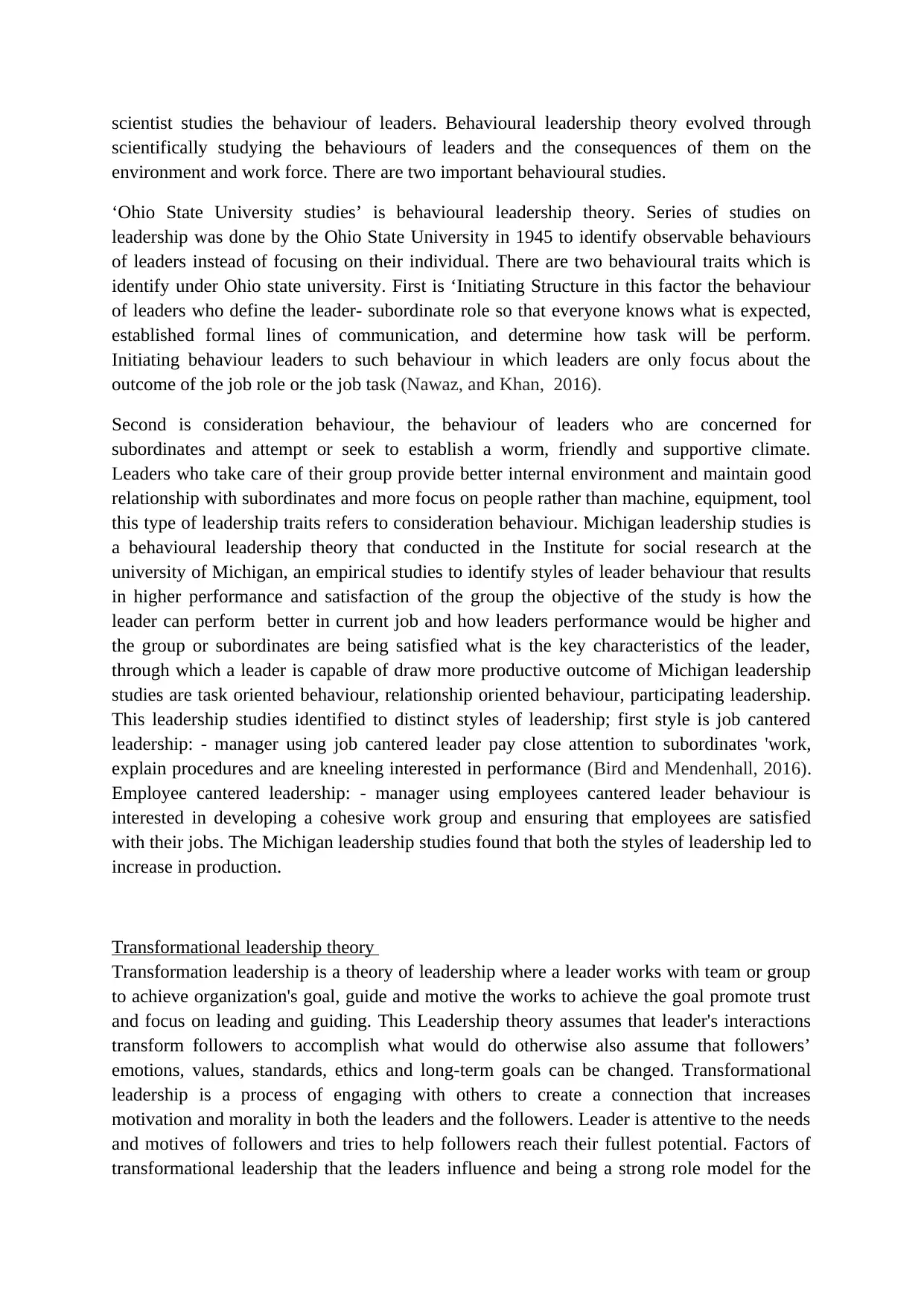
scientist studies the behaviour of leaders. Behavioural leadership theory evolved through
scientifically studying the behaviours of leaders and the consequences of them on the
environment and work force. There are two important behavioural studies.
‘Ohio State University studies’ is behavioural leadership theory. Series of studies on
leadership was done by the Ohio State University in 1945 to identify observable behaviours
of leaders instead of focusing on their individual. There are two behavioural traits which is
identify under Ohio state university. First is ‘Initiating Structure in this factor the behaviour
of leaders who define the leader- subordinate role so that everyone knows what is expected,
established formal lines of communication, and determine how task will be perform.
Initiating behaviour leaders to such behaviour in which leaders are only focus about the
outcome of the job role or the job task (Nawaz, and Khan, 2016).
Second is consideration behaviour, the behaviour of leaders who are concerned for
subordinates and attempt or seek to establish a worm, friendly and supportive climate.
Leaders who take care of their group provide better internal environment and maintain good
relationship with subordinates and more focus on people rather than machine, equipment, tool
this type of leadership traits refers to consideration behaviour. Michigan leadership studies is
a behavioural leadership theory that conducted in the Institute for social research at the
university of Michigan, an empirical studies to identify styles of leader behaviour that results
in higher performance and satisfaction of the group the objective of the study is how the
leader can perform better in current job and how leaders performance would be higher and
the group or subordinates are being satisfied what is the key characteristics of the leader,
through which a leader is capable of draw more productive outcome of Michigan leadership
studies are task oriented behaviour, relationship oriented behaviour, participating leadership.
This leadership studies identified to distinct styles of leadership; first style is job cantered
leadership: - manager using job cantered leader pay close attention to subordinates 'work,
explain procedures and are kneeling interested in performance (Bird and Mendenhall, 2016).
Employee cantered leadership: - manager using employees cantered leader behaviour is
interested in developing a cohesive work group and ensuring that employees are satisfied
with their jobs. The Michigan leadership studies found that both the styles of leadership led to
increase in production.
Transformational leadership theory
Transformation leadership is a theory of leadership where a leader works with team or group
to achieve organization's goal, guide and motive the works to achieve the goal promote trust
and focus on leading and guiding. This Leadership theory assumes that leader's interactions
transform followers to accomplish what would do otherwise also assume that followers’
emotions, values, standards, ethics and long-term goals can be changed. Transformational
leadership is a process of engaging with others to create a connection that increases
motivation and morality in both the leaders and the followers. Leader is attentive to the needs
and motives of followers and tries to help followers reach their fullest potential. Factors of
transformational leadership that the leaders influence and being a strong role model for the
scientifically studying the behaviours of leaders and the consequences of them on the
environment and work force. There are two important behavioural studies.
‘Ohio State University studies’ is behavioural leadership theory. Series of studies on
leadership was done by the Ohio State University in 1945 to identify observable behaviours
of leaders instead of focusing on their individual. There are two behavioural traits which is
identify under Ohio state university. First is ‘Initiating Structure in this factor the behaviour
of leaders who define the leader- subordinate role so that everyone knows what is expected,
established formal lines of communication, and determine how task will be perform.
Initiating behaviour leaders to such behaviour in which leaders are only focus about the
outcome of the job role or the job task (Nawaz, and Khan, 2016).
Second is consideration behaviour, the behaviour of leaders who are concerned for
subordinates and attempt or seek to establish a worm, friendly and supportive climate.
Leaders who take care of their group provide better internal environment and maintain good
relationship with subordinates and more focus on people rather than machine, equipment, tool
this type of leadership traits refers to consideration behaviour. Michigan leadership studies is
a behavioural leadership theory that conducted in the Institute for social research at the
university of Michigan, an empirical studies to identify styles of leader behaviour that results
in higher performance and satisfaction of the group the objective of the study is how the
leader can perform better in current job and how leaders performance would be higher and
the group or subordinates are being satisfied what is the key characteristics of the leader,
through which a leader is capable of draw more productive outcome of Michigan leadership
studies are task oriented behaviour, relationship oriented behaviour, participating leadership.
This leadership studies identified to distinct styles of leadership; first style is job cantered
leadership: - manager using job cantered leader pay close attention to subordinates 'work,
explain procedures and are kneeling interested in performance (Bird and Mendenhall, 2016).
Employee cantered leadership: - manager using employees cantered leader behaviour is
interested in developing a cohesive work group and ensuring that employees are satisfied
with their jobs. The Michigan leadership studies found that both the styles of leadership led to
increase in production.
Transformational leadership theory
Transformation leadership is a theory of leadership where a leader works with team or group
to achieve organization's goal, guide and motive the works to achieve the goal promote trust
and focus on leading and guiding. This Leadership theory assumes that leader's interactions
transform followers to accomplish what would do otherwise also assume that followers’
emotions, values, standards, ethics and long-term goals can be changed. Transformational
leadership is a process of engaging with others to create a connection that increases
motivation and morality in both the leaders and the followers. Leader is attentive to the needs
and motives of followers and tries to help followers reach their fullest potential. Factors of
transformational leadership that the leaders influence and being a strong role model for the
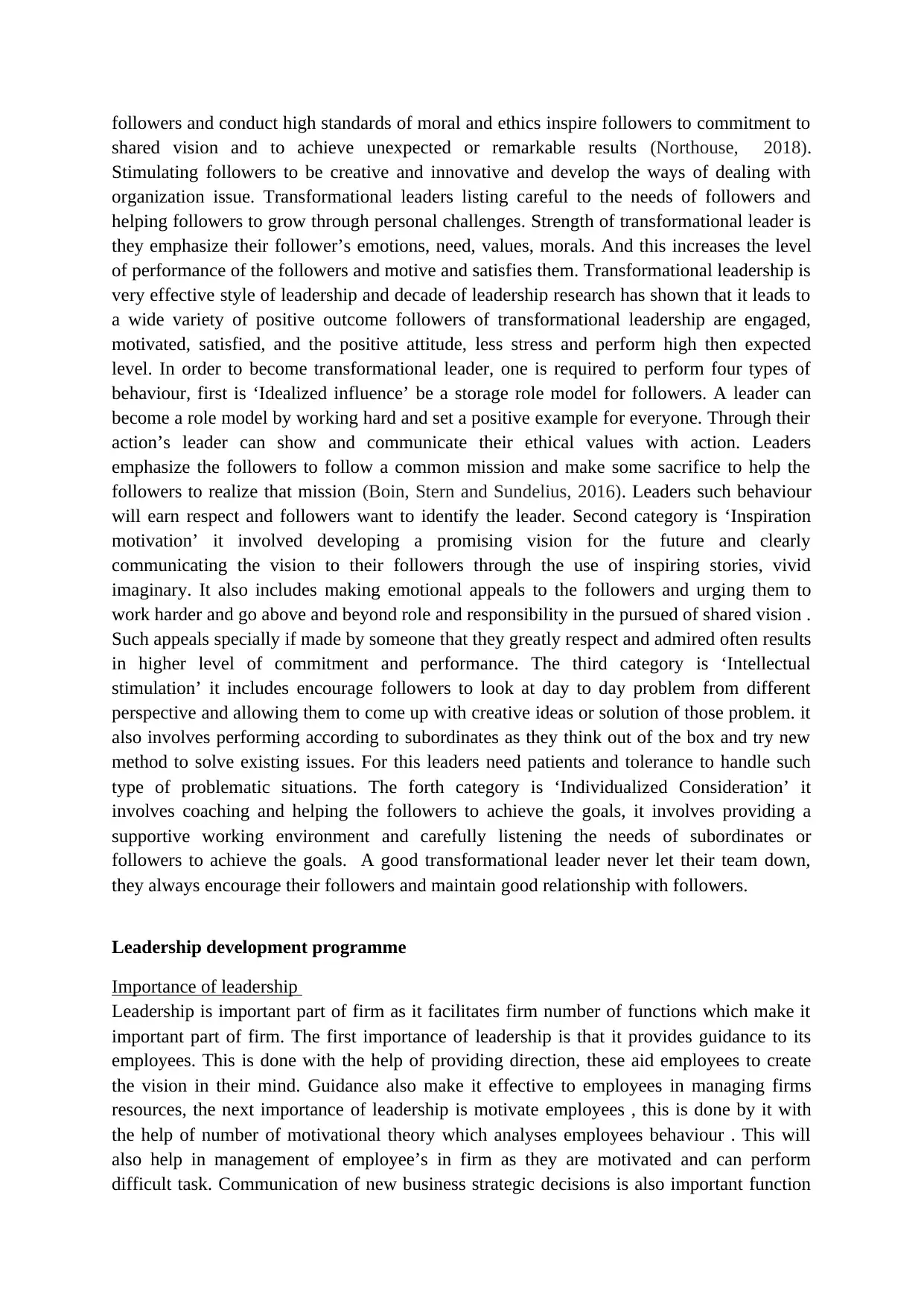
followers and conduct high standards of moral and ethics inspire followers to commitment to
shared vision and to achieve unexpected or remarkable results (Northouse, 2018).
Stimulating followers to be creative and innovative and develop the ways of dealing with
organization issue. Transformational leaders listing careful to the needs of followers and
helping followers to grow through personal challenges. Strength of transformational leader is
they emphasize their follower’s emotions, need, values, morals. And this increases the level
of performance of the followers and motive and satisfies them. Transformational leadership is
very effective style of leadership and decade of leadership research has shown that it leads to
a wide variety of positive outcome followers of transformational leadership are engaged,
motivated, satisfied, and the positive attitude, less stress and perform high then expected
level. In order to become transformational leader, one is required to perform four types of
behaviour, first is ‘Idealized influence’ be a storage role model for followers. A leader can
become a role model by working hard and set a positive example for everyone. Through their
action’s leader can show and communicate their ethical values with action. Leaders
emphasize the followers to follow a common mission and make some sacrifice to help the
followers to realize that mission (Boin, Stern and Sundelius, 2016). Leaders such behaviour
will earn respect and followers want to identify the leader. Second category is ‘Inspiration
motivation’ it involved developing a promising vision for the future and clearly
communicating the vision to their followers through the use of inspiring stories, vivid
imaginary. It also includes making emotional appeals to the followers and urging them to
work harder and go above and beyond role and responsibility in the pursued of shared vision .
Such appeals specially if made by someone that they greatly respect and admired often results
in higher level of commitment and performance. The third category is ‘Intellectual
stimulation’ it includes encourage followers to look at day to day problem from different
perspective and allowing them to come up with creative ideas or solution of those problem. it
also involves performing according to subordinates as they think out of the box and try new
method to solve existing issues. For this leaders need patients and tolerance to handle such
type of problematic situations. The forth category is ‘Individualized Consideration’ it
involves coaching and helping the followers to achieve the goals, it involves providing a
supportive working environment and carefully listening the needs of subordinates or
followers to achieve the goals. A good transformational leader never let their team down,
they always encourage their followers and maintain good relationship with followers.
Leadership development programme
Importance of leadership
Leadership is important part of firm as it facilitates firm number of functions which make it
important part of firm. The first importance of leadership is that it provides guidance to its
employees. This is done with the help of providing direction, these aid employees to create
the vision in their mind. Guidance also make it effective to employees in managing firms
resources, the next importance of leadership is motivate employees , this is done by it with
the help of number of motivational theory which analyses employees behaviour . This will
also help in management of employee’s in firm as they are motivated and can perform
difficult task. Communication of new business strategic decisions is also important function
shared vision and to achieve unexpected or remarkable results (Northouse, 2018).
Stimulating followers to be creative and innovative and develop the ways of dealing with
organization issue. Transformational leaders listing careful to the needs of followers and
helping followers to grow through personal challenges. Strength of transformational leader is
they emphasize their follower’s emotions, need, values, morals. And this increases the level
of performance of the followers and motive and satisfies them. Transformational leadership is
very effective style of leadership and decade of leadership research has shown that it leads to
a wide variety of positive outcome followers of transformational leadership are engaged,
motivated, satisfied, and the positive attitude, less stress and perform high then expected
level. In order to become transformational leader, one is required to perform four types of
behaviour, first is ‘Idealized influence’ be a storage role model for followers. A leader can
become a role model by working hard and set a positive example for everyone. Through their
action’s leader can show and communicate their ethical values with action. Leaders
emphasize the followers to follow a common mission and make some sacrifice to help the
followers to realize that mission (Boin, Stern and Sundelius, 2016). Leaders such behaviour
will earn respect and followers want to identify the leader. Second category is ‘Inspiration
motivation’ it involved developing a promising vision for the future and clearly
communicating the vision to their followers through the use of inspiring stories, vivid
imaginary. It also includes making emotional appeals to the followers and urging them to
work harder and go above and beyond role and responsibility in the pursued of shared vision .
Such appeals specially if made by someone that they greatly respect and admired often results
in higher level of commitment and performance. The third category is ‘Intellectual
stimulation’ it includes encourage followers to look at day to day problem from different
perspective and allowing them to come up with creative ideas or solution of those problem. it
also involves performing according to subordinates as they think out of the box and try new
method to solve existing issues. For this leaders need patients and tolerance to handle such
type of problematic situations. The forth category is ‘Individualized Consideration’ it
involves coaching and helping the followers to achieve the goals, it involves providing a
supportive working environment and carefully listening the needs of subordinates or
followers to achieve the goals. A good transformational leader never let their team down,
they always encourage their followers and maintain good relationship with followers.
Leadership development programme
Importance of leadership
Leadership is important part of firm as it facilitates firm number of functions which make it
important part of firm. The first importance of leadership is that it provides guidance to its
employees. This is done with the help of providing direction, these aid employees to create
the vision in their mind. Guidance also make it effective to employees in managing firms
resources, the next importance of leadership is motivate employees , this is done by it with
the help of number of motivational theory which analyses employees behaviour . This will
also help in management of employee’s in firm as they are motivated and can perform
difficult task. Communication of new business strategic decisions is also important function
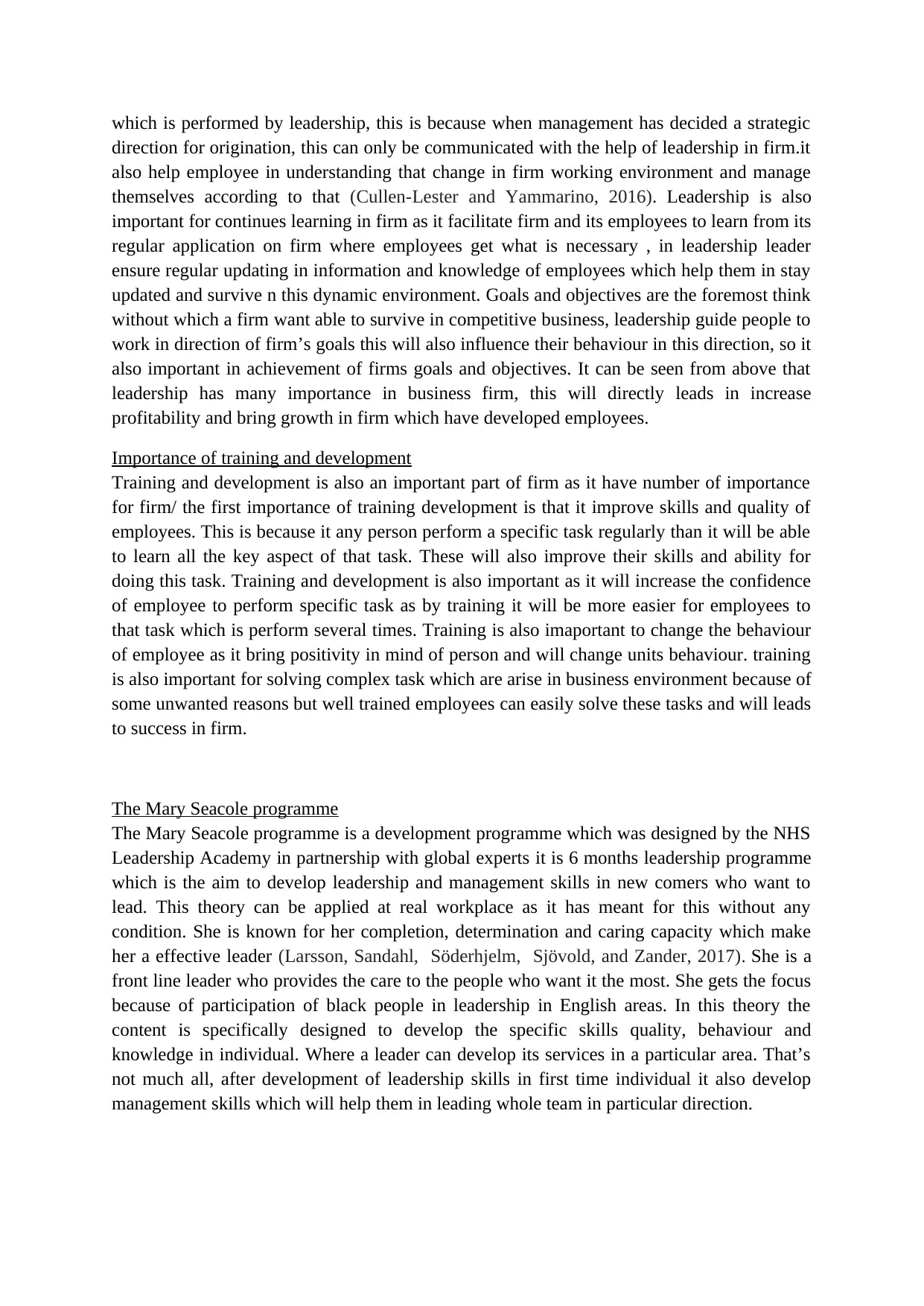
which is performed by leadership, this is because when management has decided a strategic
direction for origination, this can only be communicated with the help of leadership in firm.it
also help employee in understanding that change in firm working environment and manage
themselves according to that (Cullen-Lester and Yammarino, 2016). Leadership is also
important for continues learning in firm as it facilitate firm and its employees to learn from its
regular application on firm where employees get what is necessary , in leadership leader
ensure regular updating in information and knowledge of employees which help them in stay
updated and survive n this dynamic environment. Goals and objectives are the foremost think
without which a firm want able to survive in competitive business, leadership guide people to
work in direction of firm’s goals this will also influence their behaviour in this direction, so it
also important in achievement of firms goals and objectives. It can be seen from above that
leadership has many importance in business firm, this will directly leads in increase
profitability and bring growth in firm which have developed employees.
Importance of training and development
Training and development is also an important part of firm as it have number of importance
for firm/ the first importance of training development is that it improve skills and quality of
employees. This is because it any person perform a specific task regularly than it will be able
to learn all the key aspect of that task. These will also improve their skills and ability for
doing this task. Training and development is also important as it will increase the confidence
of employee to perform specific task as by training it will be more easier for employees to
that task which is perform several times. Training is also imaportant to change the behaviour
of employee as it bring positivity in mind of person and will change units behaviour. training
is also important for solving complex task which are arise in business environment because of
some unwanted reasons but well trained employees can easily solve these tasks and will leads
to success in firm.
The Mary Seacole programme
The Mary Seacole programme is a development programme which was designed by the NHS
Leadership Academy in partnership with global experts it is 6 months leadership programme
which is the aim to develop leadership and management skills in new comers who want to
lead. This theory can be applied at real workplace as it has meant for this without any
condition. She is known for her completion, determination and caring capacity which make
her a effective leader (Larsson, Sandahl, Söderhjelm, Sjövold, and Zander, 2017). She is a
front line leader who provides the care to the people who want it the most. She gets the focus
because of participation of black people in leadership in English areas. In this theory the
content is specifically designed to develop the specific skills quality, behaviour and
knowledge in individual. Where a leader can develop its services in a particular area. That’s
not much all, after development of leadership skills in first time individual it also develop
management skills which will help them in leading whole team in particular direction.
direction for origination, this can only be communicated with the help of leadership in firm.it
also help employee in understanding that change in firm working environment and manage
themselves according to that (Cullen-Lester and Yammarino, 2016). Leadership is also
important for continues learning in firm as it facilitate firm and its employees to learn from its
regular application on firm where employees get what is necessary , in leadership leader
ensure regular updating in information and knowledge of employees which help them in stay
updated and survive n this dynamic environment. Goals and objectives are the foremost think
without which a firm want able to survive in competitive business, leadership guide people to
work in direction of firm’s goals this will also influence their behaviour in this direction, so it
also important in achievement of firms goals and objectives. It can be seen from above that
leadership has many importance in business firm, this will directly leads in increase
profitability and bring growth in firm which have developed employees.
Importance of training and development
Training and development is also an important part of firm as it have number of importance
for firm/ the first importance of training development is that it improve skills and quality of
employees. This is because it any person perform a specific task regularly than it will be able
to learn all the key aspect of that task. These will also improve their skills and ability for
doing this task. Training and development is also important as it will increase the confidence
of employee to perform specific task as by training it will be more easier for employees to
that task which is perform several times. Training is also imaportant to change the behaviour
of employee as it bring positivity in mind of person and will change units behaviour. training
is also important for solving complex task which are arise in business environment because of
some unwanted reasons but well trained employees can easily solve these tasks and will leads
to success in firm.
The Mary Seacole programme
The Mary Seacole programme is a development programme which was designed by the NHS
Leadership Academy in partnership with global experts it is 6 months leadership programme
which is the aim to develop leadership and management skills in new comers who want to
lead. This theory can be applied at real workplace as it has meant for this without any
condition. She is known for her completion, determination and caring capacity which make
her a effective leader (Larsson, Sandahl, Söderhjelm, Sjövold, and Zander, 2017). She is a
front line leader who provides the care to the people who want it the most. She gets the focus
because of participation of black people in leadership in English areas. In this theory the
content is specifically designed to develop the specific skills quality, behaviour and
knowledge in individual. Where a leader can develop its services in a particular area. That’s
not much all, after development of leadership skills in first time individual it also develop
management skills which will help them in leading whole team in particular direction.
Paraphrase This Document
Need a fresh take? Get an instant paraphrase of this document with our AI Paraphraser
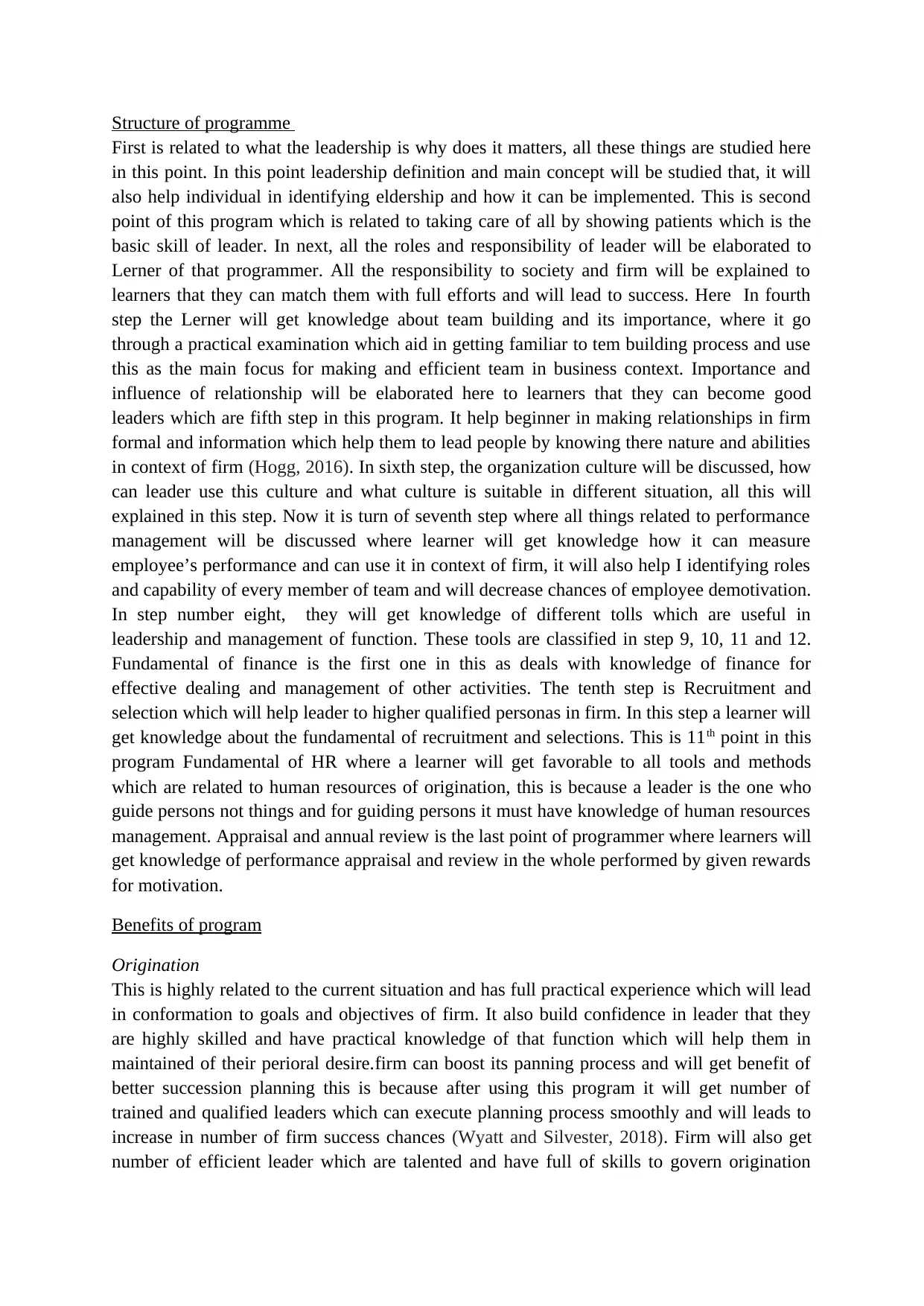
Structure of programme
First is related to what the leadership is why does it matters, all these things are studied here
in this point. In this point leadership definition and main concept will be studied that, it will
also help individual in identifying eldership and how it can be implemented. This is second
point of this program which is related to taking care of all by showing patients which is the
basic skill of leader. In next, all the roles and responsibility of leader will be elaborated to
Lerner of that programmer. All the responsibility to society and firm will be explained to
learners that they can match them with full efforts and will lead to success. Here In fourth
step the Lerner will get knowledge about team building and its importance, where it go
through a practical examination which aid in getting familiar to tem building process and use
this as the main focus for making and efficient team in business context. Importance and
influence of relationship will be elaborated here to learners that they can become good
leaders which are fifth step in this program. It help beginner in making relationships in firm
formal and information which help them to lead people by knowing there nature and abilities
in context of firm (Hogg, 2016). In sixth step, the organization culture will be discussed, how
can leader use this culture and what culture is suitable in different situation, all this will
explained in this step. Now it is turn of seventh step where all things related to performance
management will be discussed where learner will get knowledge how it can measure
employee’s performance and can use it in context of firm, it will also help I identifying roles
and capability of every member of team and will decrease chances of employee demotivation.
In step number eight, they will get knowledge of different tolls which are useful in
leadership and management of function. These tools are classified in step 9, 10, 11 and 12.
Fundamental of finance is the first one in this as deals with knowledge of finance for
effective dealing and management of other activities. The tenth step is Recruitment and
selection which will help leader to higher qualified personas in firm. In this step a learner will
get knowledge about the fundamental of recruitment and selections. This is 11th point in this
program Fundamental of HR where a learner will get favorable to all tools and methods
which are related to human resources of origination, this is because a leader is the one who
guide persons not things and for guiding persons it must have knowledge of human resources
management. Appraisal and annual review is the last point of programmer where learners will
get knowledge of performance appraisal and review in the whole performed by given rewards
for motivation.
Benefits of program
Origination
This is highly related to the current situation and has full practical experience which will lead
in conformation to goals and objectives of firm. It also build confidence in leader that they
are highly skilled and have practical knowledge of that function which will help them in
maintained of their perioral desire.firm can boost its panning process and will get benefit of
better succession planning this is because after using this program it will get number of
trained and qualified leaders which can execute planning process smoothly and will leads to
increase in number of firm success chances (Wyatt and Silvester, 2018). Firm will also get
number of efficient leader which are talented and have full of skills to govern origination
First is related to what the leadership is why does it matters, all these things are studied here
in this point. In this point leadership definition and main concept will be studied that, it will
also help individual in identifying eldership and how it can be implemented. This is second
point of this program which is related to taking care of all by showing patients which is the
basic skill of leader. In next, all the roles and responsibility of leader will be elaborated to
Lerner of that programmer. All the responsibility to society and firm will be explained to
learners that they can match them with full efforts and will lead to success. Here In fourth
step the Lerner will get knowledge about team building and its importance, where it go
through a practical examination which aid in getting familiar to tem building process and use
this as the main focus for making and efficient team in business context. Importance and
influence of relationship will be elaborated here to learners that they can become good
leaders which are fifth step in this program. It help beginner in making relationships in firm
formal and information which help them to lead people by knowing there nature and abilities
in context of firm (Hogg, 2016). In sixth step, the organization culture will be discussed, how
can leader use this culture and what culture is suitable in different situation, all this will
explained in this step. Now it is turn of seventh step where all things related to performance
management will be discussed where learner will get knowledge how it can measure
employee’s performance and can use it in context of firm, it will also help I identifying roles
and capability of every member of team and will decrease chances of employee demotivation.
In step number eight, they will get knowledge of different tolls which are useful in
leadership and management of function. These tools are classified in step 9, 10, 11 and 12.
Fundamental of finance is the first one in this as deals with knowledge of finance for
effective dealing and management of other activities. The tenth step is Recruitment and
selection which will help leader to higher qualified personas in firm. In this step a learner will
get knowledge about the fundamental of recruitment and selections. This is 11th point in this
program Fundamental of HR where a learner will get favorable to all tools and methods
which are related to human resources of origination, this is because a leader is the one who
guide persons not things and for guiding persons it must have knowledge of human resources
management. Appraisal and annual review is the last point of programmer where learners will
get knowledge of performance appraisal and review in the whole performed by given rewards
for motivation.
Benefits of program
Origination
This is highly related to the current situation and has full practical experience which will lead
in conformation to goals and objectives of firm. It also build confidence in leader that they
are highly skilled and have practical knowledge of that function which will help them in
maintained of their perioral desire.firm can boost its panning process and will get benefit of
better succession planning this is because after using this program it will get number of
trained and qualified leaders which can execute planning process smoothly and will leads to
increase in number of firm success chances (Wyatt and Silvester, 2018). Firm will also get
number of efficient leader which are talented and have full of skills to govern origination
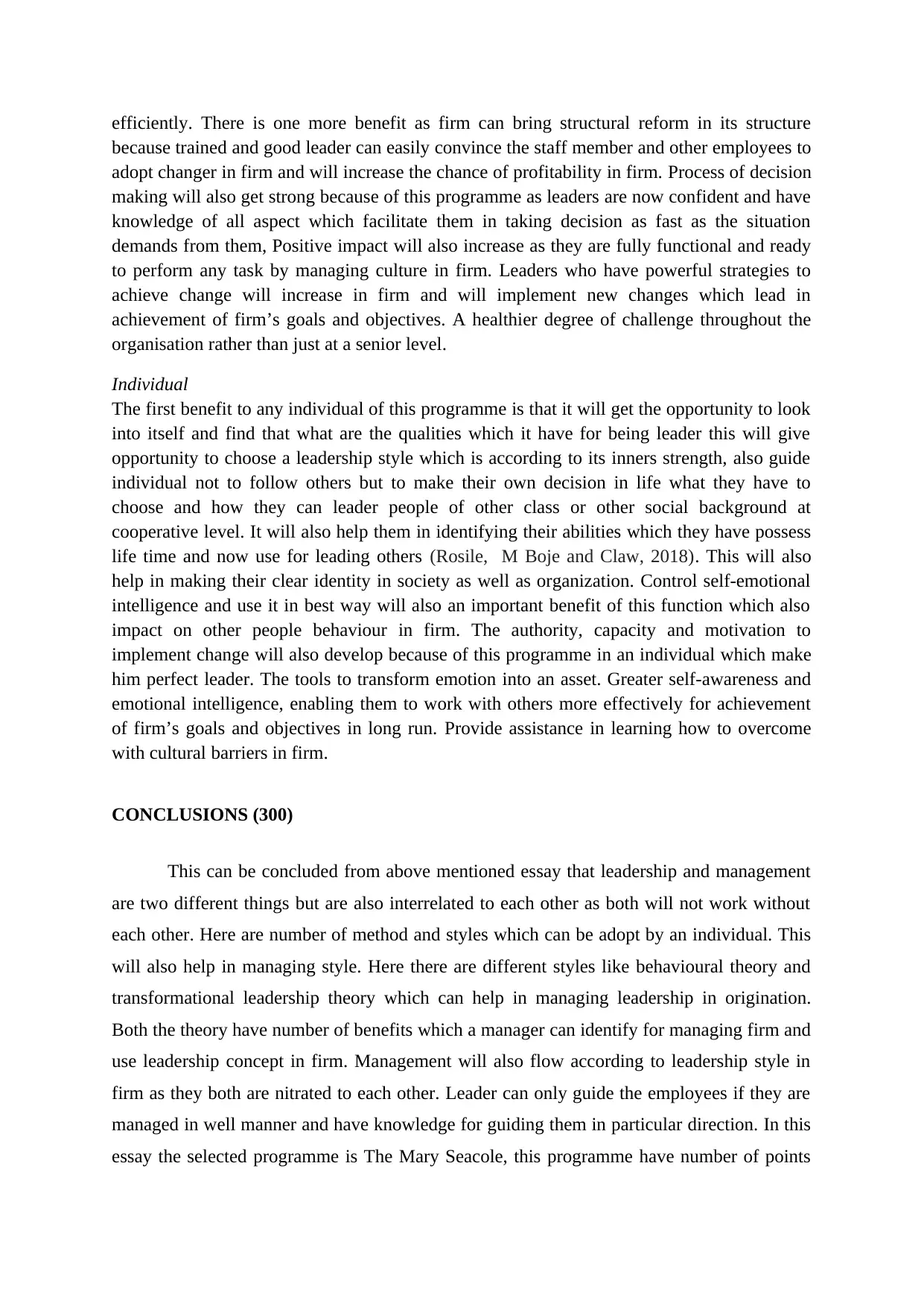
efficiently. There is one more benefit as firm can bring structural reform in its structure
because trained and good leader can easily convince the staff member and other employees to
adopt changer in firm and will increase the chance of profitability in firm. Process of decision
making will also get strong because of this programme as leaders are now confident and have
knowledge of all aspect which facilitate them in taking decision as fast as the situation
demands from them, Positive impact will also increase as they are fully functional and ready
to perform any task by managing culture in firm. Leaders who have powerful strategies to
achieve change will increase in firm and will implement new changes which lead in
achievement of firm’s goals and objectives. A healthier degree of challenge throughout the
organisation rather than just at a senior level.
Individual
The first benefit to any individual of this programme is that it will get the opportunity to look
into itself and find that what are the qualities which it have for being leader this will give
opportunity to choose a leadership style which is according to its inners strength, also guide
individual not to follow others but to make their own decision in life what they have to
choose and how they can leader people of other class or other social background at
cooperative level. It will also help them in identifying their abilities which they have possess
life time and now use for leading others (Rosile, M Boje and Claw, 2018). This will also
help in making their clear identity in society as well as organization. Control self-emotional
intelligence and use it in best way will also an important benefit of this function which also
impact on other people behaviour in firm. The authority, capacity and motivation to
implement change will also develop because of this programme in an individual which make
him perfect leader. The tools to transform emotion into an asset. Greater self-awareness and
emotional intelligence, enabling them to work with others more effectively for achievement
of firm’s goals and objectives in long run. Provide assistance in learning how to overcome
with cultural barriers in firm.
CONCLUSIONS (300)
This can be concluded from above mentioned essay that leadership and management
are two different things but are also interrelated to each other as both will not work without
each other. Here are number of method and styles which can be adopt by an individual. This
will also help in managing style. Here there are different styles like behavioural theory and
transformational leadership theory which can help in managing leadership in origination.
Both the theory have number of benefits which a manager can identify for managing firm and
use leadership concept in firm. Management will also flow according to leadership style in
firm as they both are nitrated to each other. Leader can only guide the employees if they are
managed in well manner and have knowledge for guiding them in particular direction. In this
essay the selected programme is The Mary Seacole, this programme have number of points
because trained and good leader can easily convince the staff member and other employees to
adopt changer in firm and will increase the chance of profitability in firm. Process of decision
making will also get strong because of this programme as leaders are now confident and have
knowledge of all aspect which facilitate them in taking decision as fast as the situation
demands from them, Positive impact will also increase as they are fully functional and ready
to perform any task by managing culture in firm. Leaders who have powerful strategies to
achieve change will increase in firm and will implement new changes which lead in
achievement of firm’s goals and objectives. A healthier degree of challenge throughout the
organisation rather than just at a senior level.
Individual
The first benefit to any individual of this programme is that it will get the opportunity to look
into itself and find that what are the qualities which it have for being leader this will give
opportunity to choose a leadership style which is according to its inners strength, also guide
individual not to follow others but to make their own decision in life what they have to
choose and how they can leader people of other class or other social background at
cooperative level. It will also help them in identifying their abilities which they have possess
life time and now use for leading others (Rosile, M Boje and Claw, 2018). This will also
help in making their clear identity in society as well as organization. Control self-emotional
intelligence and use it in best way will also an important benefit of this function which also
impact on other people behaviour in firm. The authority, capacity and motivation to
implement change will also develop because of this programme in an individual which make
him perfect leader. The tools to transform emotion into an asset. Greater self-awareness and
emotional intelligence, enabling them to work with others more effectively for achievement
of firm’s goals and objectives in long run. Provide assistance in learning how to overcome
with cultural barriers in firm.
CONCLUSIONS (300)
This can be concluded from above mentioned essay that leadership and management
are two different things but are also interrelated to each other as both will not work without
each other. Here are number of method and styles which can be adopt by an individual. This
will also help in managing style. Here there are different styles like behavioural theory and
transformational leadership theory which can help in managing leadership in origination.
Both the theory have number of benefits which a manager can identify for managing firm and
use leadership concept in firm. Management will also flow according to leadership style in
firm as they both are nitrated to each other. Leader can only guide the employees if they are
managed in well manner and have knowledge for guiding them in particular direction. In this
essay the selected programme is The Mary Seacole, this programme have number of points
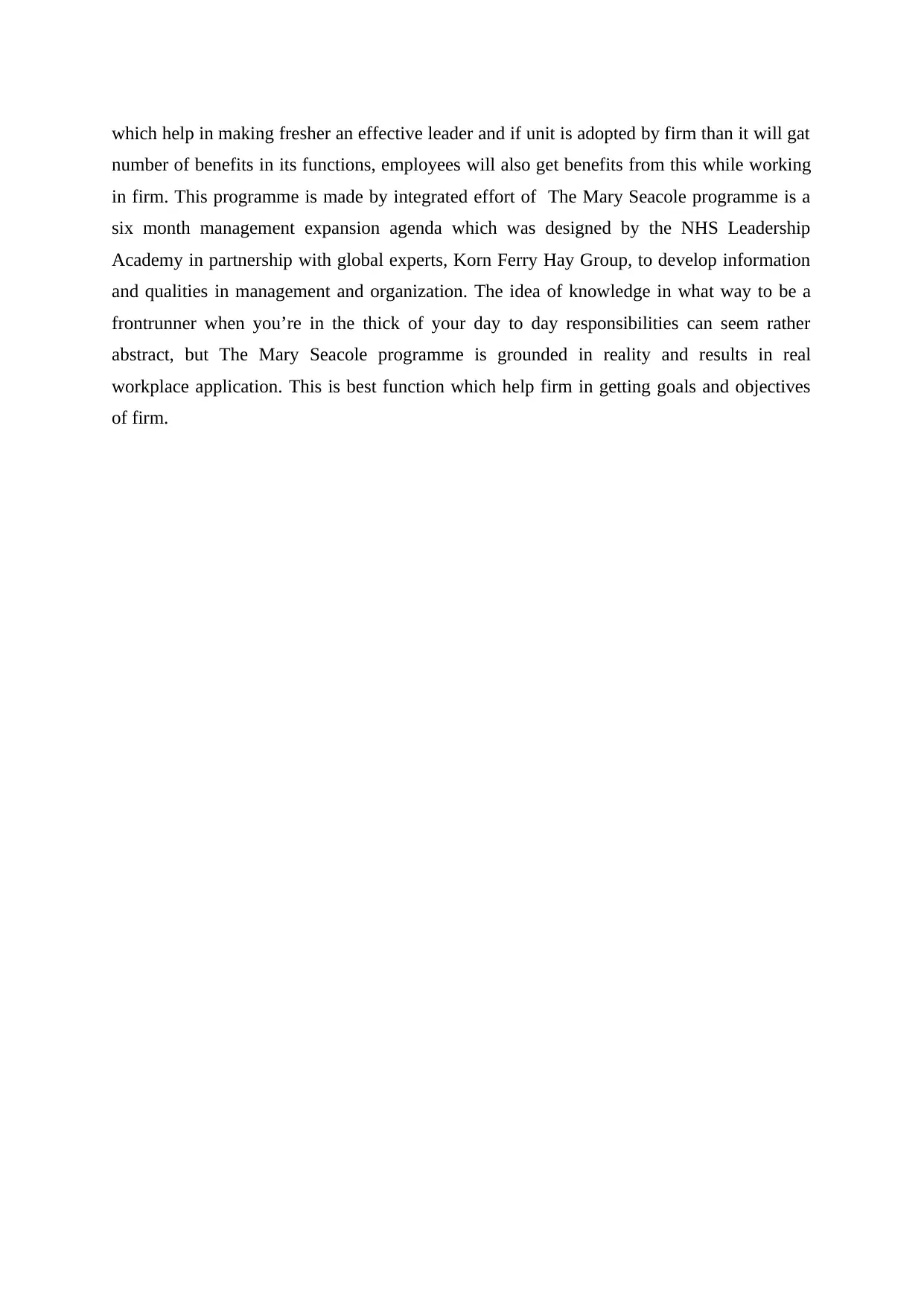
which help in making fresher an effective leader and if unit is adopted by firm than it will gat
number of benefits in its functions, employees will also get benefits from this while working
in firm. This programme is made by integrated effort of The Mary Seacole programme is a
six month management expansion agenda which was designed by the NHS Leadership
Academy in partnership with global experts, Korn Ferry Hay Group, to develop information
and qualities in management and organization. The idea of knowledge in what way to be a
frontrunner when you’re in the thick of your day to day responsibilities can seem rather
abstract, but The Mary Seacole programme is grounded in reality and results in real
workplace application. This is best function which help firm in getting goals and objectives
of firm.
number of benefits in its functions, employees will also get benefits from this while working
in firm. This programme is made by integrated effort of The Mary Seacole programme is a
six month management expansion agenda which was designed by the NHS Leadership
Academy in partnership with global experts, Korn Ferry Hay Group, to develop information
and qualities in management and organization. The idea of knowledge in what way to be a
frontrunner when you’re in the thick of your day to day responsibilities can seem rather
abstract, but The Mary Seacole programme is grounded in reality and results in real
workplace application. This is best function which help firm in getting goals and objectives
of firm.
Secure Best Marks with AI Grader
Need help grading? Try our AI Grader for instant feedback on your assignments.
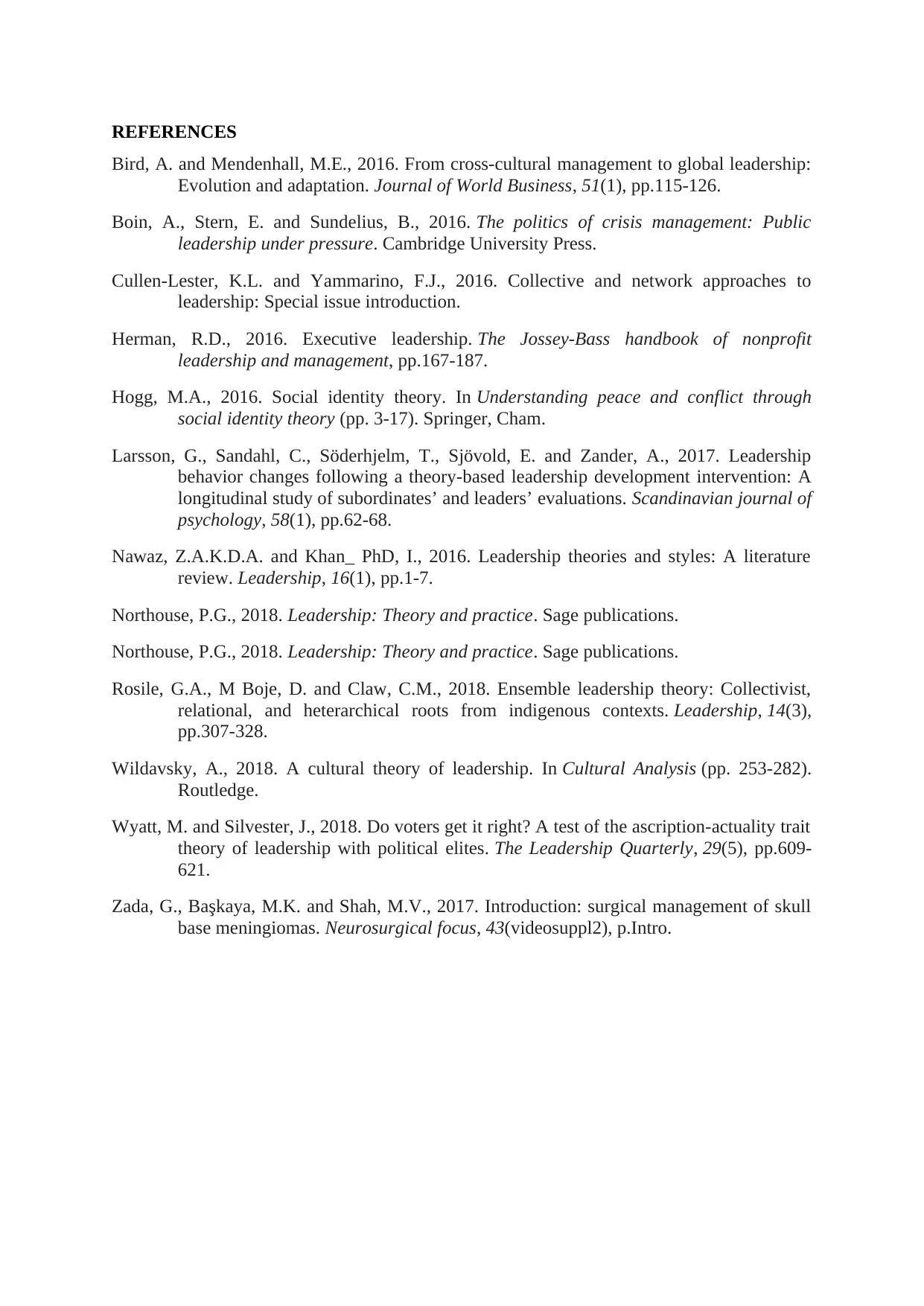
REFERENCES
Bird, A. and Mendenhall, M.E., 2016. From cross-cultural management to global leadership:
Evolution and adaptation. Journal of World Business, 51(1), pp.115-126.
Boin, A., Stern, E. and Sundelius, B., 2016. The politics of crisis management: Public
leadership under pressure. Cambridge University Press.
Cullen-Lester, K.L. and Yammarino, F.J., 2016. Collective and network approaches to
leadership: Special issue introduction.
Herman, R.D., 2016. Executive leadership. The Jossey-Bass handbook of nonprofit
leadership and management, pp.167-187.
Hogg, M.A., 2016. Social identity theory. In Understanding peace and conflict through
social identity theory (pp. 3-17). Springer, Cham.
Larsson, G., Sandahl, C., Söderhjelm, T., Sjövold, E. and Zander, A., 2017. Leadership
behavior changes following a theory‐based leadership development intervention: A
longitudinal study of subordinates’ and leaders’ evaluations. Scandinavian journal of
psychology, 58(1), pp.62-68.
Nawaz, Z.A.K.D.A. and Khan_ PhD, I., 2016. Leadership theories and styles: A literature
review. Leadership, 16(1), pp.1-7.
Northouse, P.G., 2018. Leadership: Theory and practice. Sage publications.
Northouse, P.G., 2018. Leadership: Theory and practice. Sage publications.
Rosile, G.A., M Boje, D. and Claw, C.M., 2018. Ensemble leadership theory: Collectivist,
relational, and heterarchical roots from indigenous contexts. Leadership, 14(3),
pp.307-328.
Wildavsky, A., 2018. A cultural theory of leadership. In Cultural Analysis (pp. 253-282).
Routledge.
Wyatt, M. and Silvester, J., 2018. Do voters get it right? A test of the ascription-actuality trait
theory of leadership with political elites. The Leadership Quarterly, 29(5), pp.609-
621.
Zada, G., Başkaya, M.K. and Shah, M.V., 2017. Introduction: surgical management of skull
base meningiomas. Neurosurgical focus, 43(videosuppl2), p.Intro.
Bird, A. and Mendenhall, M.E., 2016. From cross-cultural management to global leadership:
Evolution and adaptation. Journal of World Business, 51(1), pp.115-126.
Boin, A., Stern, E. and Sundelius, B., 2016. The politics of crisis management: Public
leadership under pressure. Cambridge University Press.
Cullen-Lester, K.L. and Yammarino, F.J., 2016. Collective and network approaches to
leadership: Special issue introduction.
Herman, R.D., 2016. Executive leadership. The Jossey-Bass handbook of nonprofit
leadership and management, pp.167-187.
Hogg, M.A., 2016. Social identity theory. In Understanding peace and conflict through
social identity theory (pp. 3-17). Springer, Cham.
Larsson, G., Sandahl, C., Söderhjelm, T., Sjövold, E. and Zander, A., 2017. Leadership
behavior changes following a theory‐based leadership development intervention: A
longitudinal study of subordinates’ and leaders’ evaluations. Scandinavian journal of
psychology, 58(1), pp.62-68.
Nawaz, Z.A.K.D.A. and Khan_ PhD, I., 2016. Leadership theories and styles: A literature
review. Leadership, 16(1), pp.1-7.
Northouse, P.G., 2018. Leadership: Theory and practice. Sage publications.
Northouse, P.G., 2018. Leadership: Theory and practice. Sage publications.
Rosile, G.A., M Boje, D. and Claw, C.M., 2018. Ensemble leadership theory: Collectivist,
relational, and heterarchical roots from indigenous contexts. Leadership, 14(3),
pp.307-328.
Wildavsky, A., 2018. A cultural theory of leadership. In Cultural Analysis (pp. 253-282).
Routledge.
Wyatt, M. and Silvester, J., 2018. Do voters get it right? A test of the ascription-actuality trait
theory of leadership with political elites. The Leadership Quarterly, 29(5), pp.609-
621.
Zada, G., Başkaya, M.K. and Shah, M.V., 2017. Introduction: surgical management of skull
base meningiomas. Neurosurgical focus, 43(videosuppl2), p.Intro.
1 out of 11
Related Documents
Your All-in-One AI-Powered Toolkit for Academic Success.
+13062052269
info@desklib.com
Available 24*7 on WhatsApp / Email
![[object Object]](/_next/static/media/star-bottom.7253800d.svg)
Unlock your academic potential
© 2024 | Zucol Services PVT LTD | All rights reserved.





